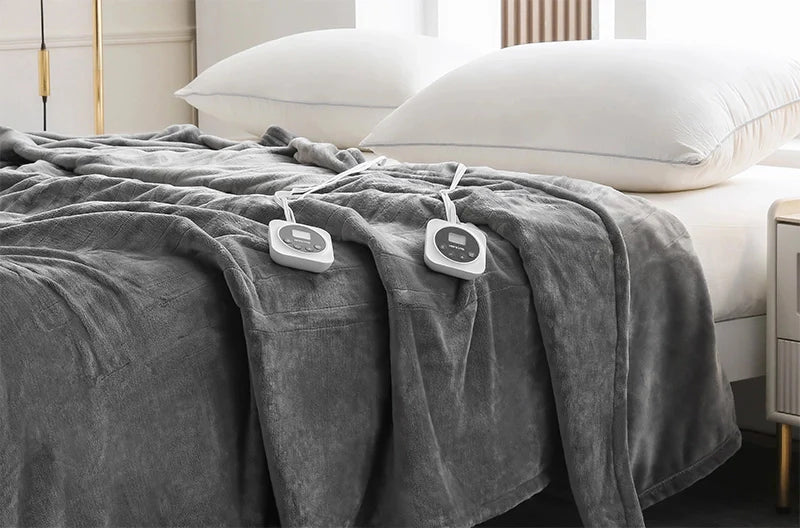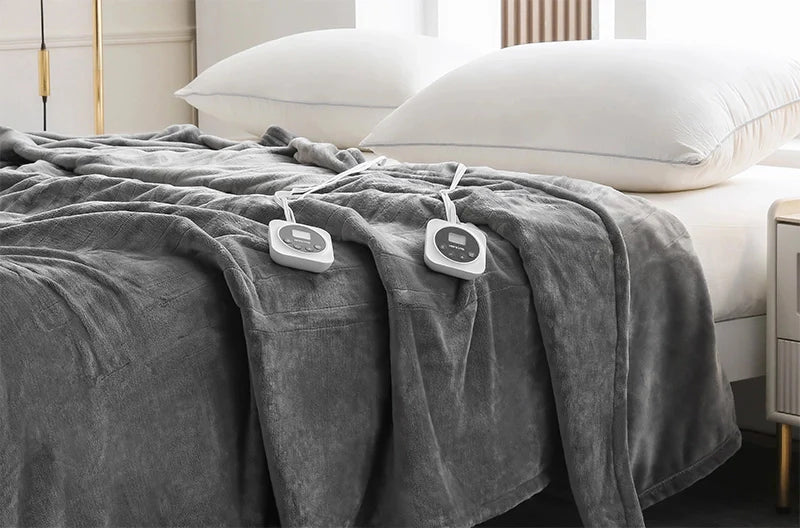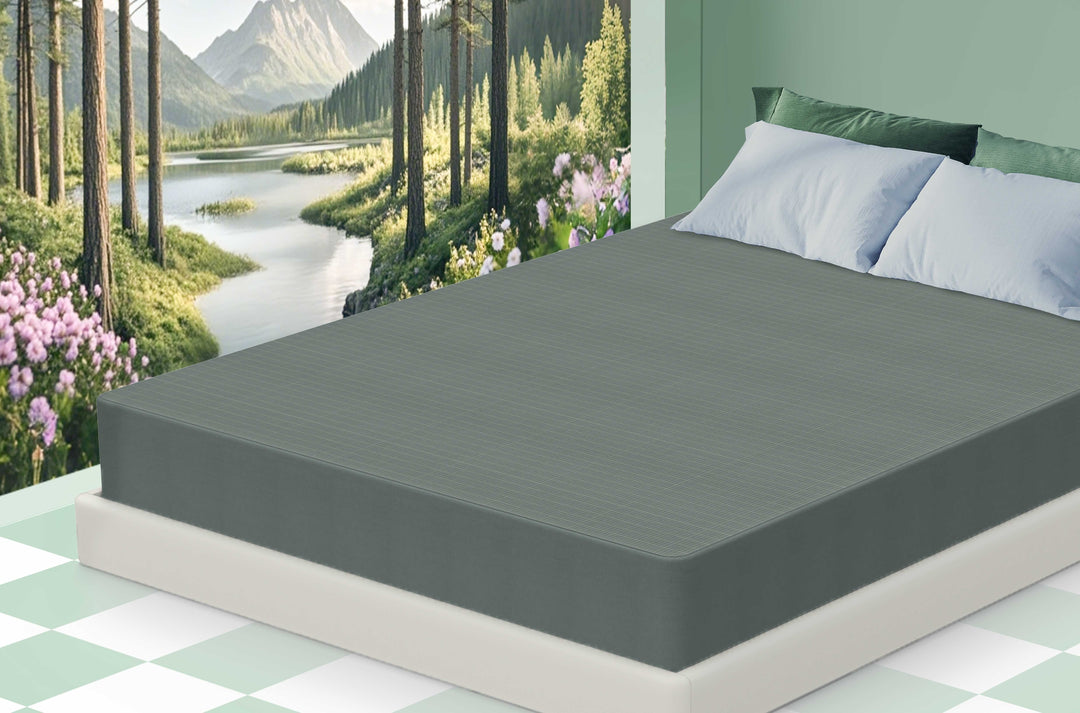How to Test Grounding Sheets: A Simple Guide for Accurate Results
You spent good money on grounding sheets, but how do you actually know they're working? Here's a mind-bender: most of the grounding products fail their first test due to improper setup—not product defects. Testing your sheets takes just 10 minutes and could be the difference between real earthing benefits and expensive placebo bedding.
Learn how to quickly and easily test your grounding sheets to ensure they provide real earthing benefits. This step-by-step guide covers tools, safety tips, testing methods, troubleshooting, and maintenance to maximize your sheet’s performance. No electrical degree required.
Tools You'll Need to Test Grounding Sheets
Before experiencing the health benefits of your earthing sheets, the right testing equipment is necessary for the grounding sheet test.
#1 Grounding Outlet Tester
This pocket-sized gadget is your first line of defense. Choose a model rated for 110–125V, 50/60Hz to match standard North American home outlets. It checks if your wall outlet has a proper ground connection before you even unpack your bed sheets.
- How it works: Plug it in, and three LED lights tell you instantly if your outlet is wired correctly. Two yellow lights = good to go. Any other combo means call an electrician.
- Pro tip: Test every outlet in your bedroom. Just because one works doesn't mean they all do. Older homes, especially, can have mixed results.

#2 Multimeter
A multimeter is a versatile tool that measures voltage and continuity, using it to verify your sheet's conductivity—basically confirming those silver fibers in your Homlyns grounding sheets are doing their job.
- Digital vs. Analog: Digital displays exact numbers (easier for beginners). Analog uses a needle gauge (preferred by some pros). Both work fine for testing earthing sheets.

#3 Grounding Continuity Tester
This specialized tool checks if electricity can flow continuously from your sheet to the ground. It's like a metal detector but for electrical pathways.
- Key feature: Most models beep or light up when they detect a complete circuit. No sound = no ground connection.
- Budget hack: Some multimeters have continuity mode built in. Check yours before buying a separate tester.

#4 Grounding Test Pen
The simplest option for quick checks. Touch the pen to your sheet—if it lights up, you've got conductivity.
- Best for: Spot-checking specific areas of your sheet or testing after washing. Less precise than a multimeter but perfect for weekly maintenance checks.
- Watch out: These pens need batteries. Dead battery = false negative results.

🆚 Quick breakdown:
| Tool | Purpose | Accuracy | Best For | Cost |
| Outlet Tester | Checks if an outlet is properly grounded | High | Initial setup | $10–15 |
| Multimeter | Measures voltage and continuity | Very High | All users | $20–40 |
| Continuity Tester | Confirms continuity through conductive materials | Medium | Spot-checking | $15–30 |
| Grounding Test Pen | Detects electrical presence via light or sound | Low–Medium | Weekly checks | $10–20 |
Start with an outlet tester and multimeter. That $30-50 investment covers 90% of testing needs.
For your convenience, Homlyns Grounding Sheets include an outlet tester and grounding test pen for easy setup verification. For advanced testing, you can purchase a multimeter separately.
Steps to Test Your Earthing Bed Sheets
Time to put those tools to work. Follow these steps in order—each builds on the last to give you complete confidence in your grounding setup.
‼️ Safety Precautions Before Testing
- Turn off nearby electrical devices to minimize electromagnetic interference.
- Keep hands and feet dry — moisture can affect readings and increase the risk of electric shock.
- Avoid testing in wet conditions to prevent accidents.
- Never perform tests during storms to avoid the danger of power surges or lightning strikes.
- Plug grounding cords directly into grounded wall outlets — do not use surge protectors or power strips.
- Use a certified earthing adaptor if your outlet lacks a grounding port.
- Always check which socket hole to insert into before testing to prevent electric shock or injury.
Step 1: Visual Inspection
Your eyes are the first testing tool. A quick visual check catches 80% of issues before you even grab a meter.

🔍 What to check:
- Connection cord: Look for kinks, cuts, or exposed wires. The cord should snap firmly into your sheet's connection point
- Silver fibers: Homlyns grounding bed sheets have a subtle silver sheen. If areas look dull or discolored, those spots might have lost conductivity
- Snap connectors: Should be shiny metal, not corroded or loose. Wiggle them—any movement means a poor connection
🚩 Red flags: Visible tears, dark oxidation spots, or connection points that feel loose. These need fixing before electrical testing.
💡 Quick fix: Tarnished snaps? Clean with a pencil eraser. Works like magic.
Step 2: Outlet Connection Test
No point testing sheets if your outlet isn't grounded properly. This takes 30 seconds and saves hours of troubleshooting.
🛠️ Tool:
Outlet Checker
📋 Steps:
- Plug the grounding outlet tester into your wall socket
- Check the light pattern (usually takes 2-3 seconds)
- Match the lights to the tester's chart
🔍 Reading results:
| Light Pattern (Left – Center – Right) | Diagnosis | Meaning | Action Needed |
|
OFF – ON – OFF ⚪️ 🟡 ⚪️ |
OPEN GROUND | Ground wire is missing | ❌ Unsafe – Do not use for grounding |
|
OFF – OFF – ON ⚪️ ⚪️ 🟡 |
OPEN NEUTRAL | Neutral wire is disconnected | ❌ Unsafe – Call an electrician |
|
OFF – OFF – OFF ⚪️ ⚪️ ⚪️ |
OPEN HOT | No hot wire – no power | ⚠️ Outlet dead – check circuit |
|
ON – OFF – ON 🔴 ⚪️ 🟡 |
HOT / GROUND REVERSE | Hot and ground wires reversed | ❌ Dangerous – needs correction |
|
ON – ON – OFF 🔴 🟡 ⚪️ |
HOT / NEUTRAL REVERSE | Hot and neutral wires reversed | ❌ Dangerous – needs correction |
|
OFF – ON – ON ⚪️ 🟡 🟡 |
✅ CORRECT | Properly grounded and wired | ✔ Safe to use for grounding sheets |
❓ Troubleshooting a Failed Grounding Connection:
- Try other outlets in the room—many bedrooms have at least one grounded outlet, often near windows.
- If no outlet tests correctly, consider using a grounding rod for outdoor earthing.
- For long-term safety, consult a licensed electrician to inspect and properly ground your outlets.
Step 3: Continuity Test
Continuity confirms your entire grounding path works—from the sheet to Earth. Think of it as checking if the highway is open all the way to your destination.
🛠️ Tool:
Use one of the following—a multimeter, a grounding continuity tester, or a grounding test pen.
✅ Using a Multimeter (Continuity Mode):
-
Set your multimeter to the continuity (diode or sound wave) setting—usually shared with resistance (Ω) on most meters.
- Snap the cord to the sheet and plug the other end into a grounded outlet.
-
Touch the black probe to the snap connector.
-
Touch the red probe to the silver-threaded area of the sheet.
-
If the multimeter beeps or shows a low resistance reading, it means the silver threads are conductive and the sheet is functioning properly.
✅ Using a grounding continuity tester:
- Connect your sheet to a properly grounded wall outlet.
- Snap the tester’s cord onto the continuity tester and plug the other end into the outlet.
-
Hold the tester with one finger on the metal plate on the back and press the button with another finger.
-
Touch or lie on the sheet — a green light means the grounding connection is working.
-
Step away from the sheet — the light should turn off, confirming the tester is responding correctly.
0:41~1:03
✅ Using a grounding test pen:
- Plug the grounding cord into the sheet and a properly grounded wall outlet.
- Hold the test pen and touch the tip to different sheet areas. Bright light = good connection.
- If there’s no light when plugged in, the test pen’s batteries may be exhausted. Replace the batteries and test again.
-
Unplug and retest—no light confirms the original connection worked.
5:30~6:22
❓Troubleshooting:
- No continuity (no beep or signal): This may be caused by a broken wire or damaged connector. Check for visible damage and replace the grounding cord if needed.
- Only part of the product is conductive: This likely indicates worn-out conductive material. Test multiple areas—if some respond and others don’t, the earthing bed sheet is degrading and may need replacement.
- Weak signal or inconsistent reading: This is often due to a dirty or oxidized surface. Clean the sheet with a damp cloth and mild soap to restore conductivity.
💡 Smart tips:
- Check in a grid—every 12 inches across the sheet. One dead spot can break your grounding if that's where you sleep.
- Mark dead spots with a washable fabric marker. If they expand over time, your sheet's wearing out.
Step 4: Body Voltage Test
The ultimate proof—measuring actual voltage leaving your body through the sheet. This advanced test shows grounding in action.
🛠️ Tool:
Multimeter
📋 Steps:
- Set your multimeter to AC voltage (V~) mode. Choose 200V for best accuracy.
- Plug the grounding cord of your sheet into the ground port of a wall outlet.
- Touch the black (COM) probe to the snap or sliver-threaded area on your sheet.
- Hold the red (positive) probe in your hand or place it directly against your skin.
- Note the voltage reading — this is your baseline.
- Now touch or lie on the grounding sheet
- Watch the voltage drop—it should fall significantly, indicating effective grounding.
🔍 Reading results:
- Significant voltage drop: Indicates your body is effectively discharging voltage through the grounding sheet.
- Little or no change: Suggests poor grounding or a problem with the sheet, cord, or outlet connection. Recheck all connections or consult an electrician if unsure.
❓ Troubleshooting
If your body voltage doesn’t drop after touching the grounding bed sheet, try these fixes:
- No change in body voltage: This may be due to a faulty grounding cord or ungrounded outlet. Re-test the outlet using a grounding tester and replace the cord if necessary.
- Voltage drop is minimal: You might not be making proper contact with the grounding product. Make sure your skin is in direct contact—avoid placing blankets or clothing between your body and the sheet.
- Inconsistent readings: Electrical noise from nearby devices could be interfering with the test. Turn off electronics and move away from large appliances or power strips during testing.
🗯️ Testing schedule summary:
- Visual inspection: Before every use
- Outlet test: Once during setup
- Continuity test: Monthly
- Body voltage test: Quarterly or when issues arise
Takes 10 minutes monthly to ensure you're getting maximum earthing benefits. Worth it? Ask anyone who's slept on a dead grounding sheet for months without knowing.
⚠️ Reminder: The effectiveness of the product cannot be judged solely by the measured resistance value, because resistance only indicates electrical flow between two points—it doesn’t confirm proper grounding, outlet safety, or full circuit integrity. Be sure to use the recommended testing methods outlined in this article for accurate results.
How Often Should You Test Your Earthing Sheets
Your earthing sheets don't announce when they stop working. They just... stop. That's why regular testing beats hoping for the best. You'd better test your earthing (grounding) sheets at least once a month to ensure they are still effectively conducting electricity and connected to a true ground.
Why Regular Testing Matters:
-
Silver threads can break down or lose conductivity over time.
-
Grounding cords may loosen or degrade.
-
Wall outlets may lose ground connection or become ungrounded.
-
Cleaning can affect conductivity if not done properly.
After these events, test immediately:
-
Moving or rearranging bedroom furniture
-
Electrical work in your home
-
Power outages or storms
-
Every 5-10 washes (silver fibers are sensitive)
-
If grounding benefits fade (e.g., poor sleep, discomfort, restlessness)
What to Do If Your Grounding Sheet Fails the Test
Don't panic. Most "failed" grounding sheets just need simple fixes, not replacement.
Troubleshooting Checklist (In Order)
-
Check the basics first:
-
Is your outlet properly grounded? (Retest it)
-
Did you test the correct side of the sheet? (Conductive side up)
-
Are all connections finger-tight?
-
-
Clean the connection points:
-
Unsnap the grounding cord
-
Clean both snap parts with rubbing alcohol
-
Use fine sandpaper on stubborn oxidation
-
Reattach and retest
-
-
Check the fabric areas:
-
For dirty surfaces, wipe with a damp cloth and mild soap
-
Clean dark oxidation spots gently using rubbing alcohol and a soft cloth
-
Worn-out or damaged conductive fibers cannot be repaired effectively; replacement is recommended for proper grounding
-
-
Test your backup equipment: Sometimes it's not the sheet. Test your grounding mats or other earthing products with the same meter. If everything fails, your testing equipment might need new batteries.
The Professional Recovery Method
Still getting bad readings after basic troubleshooting? Try this deep restoration:
-
Soak the sheet in warm water + 1 cup white vinegar (30 minutes)
-
Rinse thoroughly with distilled water
-
Air dry completely—never use high heat
-
Retest when fully dry
This process removes soap residue, body oils, and mineral buildup that block conductivity. Works about 70% of the time for sheets under 2-3 years old.
Pro tip: Keep a testing log and note the dates. When the sheet no longer works consistently despite cleaning, you'll know it's time to invest in new Homlyns grounding sheets with fresh silver fiber content.
When Cleaning Can't Save Your Sheet
Some problems mean it's replacement time:
-
Dead zones spreading: If you notice more non-conductive zones over time, it may indicate natural fiber fatigue, especially in sheets used for several years.
-
Physical damage: Tears, holes, or separated seams break the conductive pathways. Small holes near edges? Manageable. Large tears where you sleep? Time for new sheets.
When to Replace Your Grounding Sheet
Even the best earthing sheets don't last forever. Like your favorite jeans, they wear out—but unlike denim, you can't see when the electrons stop flowing.
Long-Lasting with Proper Care
With mindful maintenance, many grounding sheets can continue working effectively for years. But several factors determine actual lifespan:
-
Daily 8+ hour use = check after 18 months
-
Multiple users or pets = expect 20% shorter life
-
Frequent washing (2x weekly) = silver degrades faster
Clear Signs It's Time for New Sheets
Electrical failures:
-
Multimeter shows "OL" (overload) in multiple spots
-
Zero conductivity in your main sleep area
-
Connection points crumble or won't stay attached
Physical breakdown:
-
Silver threads visibly missing or black
-
Fabric feels different—lost that subtle metallic texture
-
Holes or thin spots where insulation has worn through
Performance changes:
-
Your body acts like an antenna for electronics again
-
Morning grogginess returns despite good sleep habits
-
Static electricity becomes your unwanted companion
Maintenance & Care Tips for Grounding Effectiveness
Proper maintenance doubles your sheet's lifespan. These aren't suggestions—they're essential for preserving conductivity.

Washing Without Destroying Silver
The golden rules:
-
Cold water only—heat oxidizes silver faster than you can explain
-
Gentle cycle—aggressive agitation breaks conductive threads
-
Mild detergent—no bleach, fabric softener, or whiteners
-
Line dry when possible—if using dryer, lowest heat setting
Monthly deep clean protocol:
-
Add 1/2 cup white vinegar to rinse cycle
-
Removes mineral buildup and soap residue
-
Restores conductivity by 10-15% on average
Further Reading:
Daily Habits That Preserve Function
-
Moisture management: Your sheet shouldn't stay damp. After night sweats or spills, air it out. Constant moisture accelerates silver breakdown.
-
Rotation strategy: If possible, switch between two sheets weekly. Like running shoes, they last longer with rest periods.
-
Connection care: Unsnap and clean all connection points monthly. Never yank the cord—always grip the snap directly. Store any extra cord length loosely coiled to avoid kinks or damage.
Storage and Seasonal Guidance
-
Clean and completely dry before storing
-
Roll, don't fold (creases can break conductivity)
-
Store in a breathable cotton bag, not plastic
-
Add silica packets to prevent moisture
🏖️ Vacation protocol: Disconnect from the outlet during extended absence. It's not about saving electricity—it prevents potential fault current issues during storms.
What NOT to Do (The Sheet Killers)
These mistakes turn good sheets into expensive cotton:
-
Iron or steam—extreme heat destroys silver instantly
-
Dry cleaning—chemicals intended for industrial use strip conductivity
-
Brightening agents—optical brighteners create an insulation layer
-
Hot water wash—even once, can cause 50% conductivity loss
🐾 The pet factor: Claws create micro-tears that spread. Use a thin cotton sheet on top if pets share your bed. Slightly reduces grounding but protects your investment.
Ready to Keep Your Earthing Benefits Flowing with Homlyns?
Testing your earthing bed sheets isn't rocket science—it's more like checking your tire pressure. A few minutes monthly prevents you from sleeping on dead sheets for weeks without knowing. Your body deserves better than pretend grounding.
Key takeaways:
-
Start with basic tools: outlet tester + multimeter ($35 total)
-
Test monthly, clean connections quarterly for consistent sleep benefits
-
Wash cold, skip fabric softener, air dry when possible
-
Most issues are connection problems, not sheet failure
Quality matters when you're counting on nightly earthing benefits. Homlyns grounding sheets combine 95% organic cotton with 5% pure silver fiber—the sweet spot for conductivity and comfort. Priced affordably at $89–$99, they offer long-term value with a lifespan of several years when properly tested and cared for.
📖 Related Posts
- Grounding Therapy 101: A Beginner's Guide
- How Can You Ground Your Bed?
- How to Ground in the Winter
- Does Grounding Work with Socks?
- Grounding Fitted Sheets vs. Flat Sheets
- What Materials are Best for Grounding Sheets
















Leave a comment